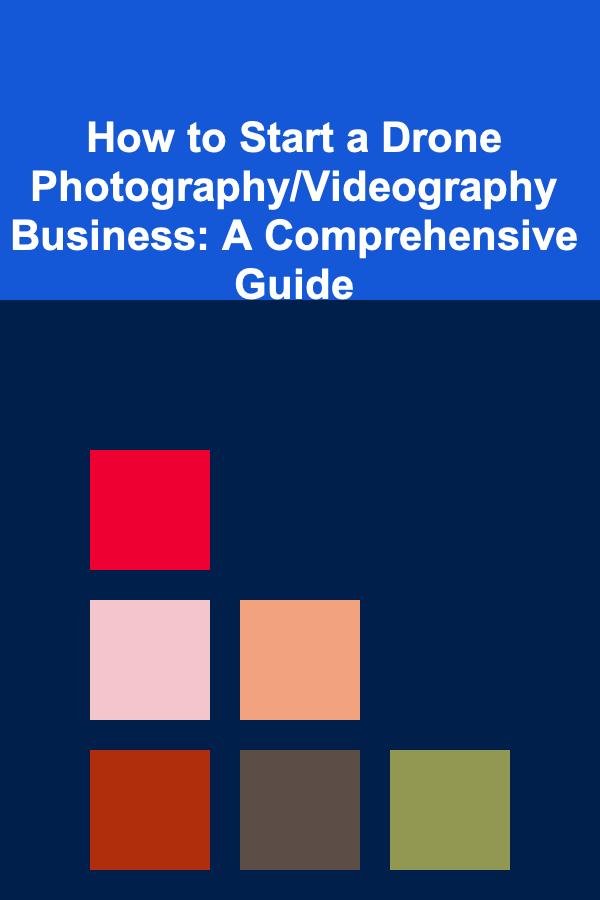
How to Start a Drone Photography/Videography Business: A Comprehensive Guide
ebook include PDF & Audio bundle (Micro Guide)
$12.99$9.99
Limited Time Offer! Order within the next:

The drone photography and videography industry is booming, offering incredible opportunities for creative individuals and entrepreneurs. The ability to capture stunning aerial perspectives has opened doors for various applications, from real estate and construction to weddings and tourism. However, starting a successful drone business requires more than just owning a drone and having a passion for flying. It demands a solid understanding of regulations, technical skills, business acumen, and marketing strategies. This comprehensive guide will walk you through every step of launching and growing a thriving drone photography/videography business.
Legal and Regulatory Compliance: The Foundation of Your Business
Before even considering purchasing equipment or taking on clients, understanding and adhering to all applicable laws and regulations is paramount. Operating a drone without proper certification and knowledge can lead to hefty fines, legal repercussions, and reputational damage. Regulations vary significantly depending on your location, so thorough research is crucial.
1.1. FAA Regulations (United States)
In the United States, the Federal Aviation Administration (FAA) governs drone operations. Here's a breakdown of key requirements:
- Part 107 Certification: This is the cornerstone of legal commercial drone operation. To obtain a Part 107 Remote Pilot Certificate, you must be at least 16 years old, pass an FAA knowledge test, and undergo TSA security vetting. The test covers topics such as airspace regulations, weather, drone operations, and emergency procedures. Regular recurrent training is required to maintain your certification.
- Drone Registration: All drones weighing between 0.55 lbs (250 grams) and 55 lbs (25 kg) must be registered with the FAA. Registration involves providing your name, address, and drone information.
- Operational Restrictions: Part 107 outlines specific operational restrictions, including:
- Visual Line of Sight (VLOS): The drone must be within your visual line of sight at all times, or the visual line of sight of a visual observer who is co-located and in direct communication with you.
- Altitude Limits: Drones cannot be flown higher than 400 feet above ground level (AGL) or within 400 feet of a structure.
- Airspace Restrictions: You cannot fly in controlled airspace (near airports) without obtaining prior authorization from the FAA. The FAA's Low Altitude Authorization and Notification Capability (LAANC) system allows for automated airspace authorization requests in many controlled airspace areas.
- Night Operations: Night operations require a waiver from the FAA, which necessitates specific training and equipment requirements, including anti-collision lighting.
- Flying Over People: Flying over people is generally prohibited without a waiver, which requires demonstrating a low risk of injury in the event of a crash. There are specific drone categories (based on weight and design) that allow for certain types of operations over people without a waiver, but these categories come with stringent requirements.
- Operating From a Moving Vehicle or Aircraft: Generally prohibited unless operating over sparsely populated areas.
- Waivers and Authorizations: The FAA offers waivers and authorizations for certain restrictions, allowing for operations that would otherwise be prohibited. Obtaining a waiver requires a thorough risk assessment and demonstration that you can safely conduct the operation. Common waivers include flying at night or flying over people.
1.2. International Regulations
If you plan to operate your drone business outside of the United States, you must research and comply with the regulations of the country you are operating in. Each country has its own set of rules and regulations, which may be significantly different from those in the US. Key areas to investigate include:
- Registration and Licensing: Determine if you need to register your drone with the local aviation authority and obtain a pilot license or permit.
- Airspace Restrictions: Understand the local airspace restrictions and prohibited areas, such as airports, military installations, and government buildings.
- Privacy Laws: Be aware of local privacy laws regarding the collection and use of aerial imagery.
- Operational Restrictions: Familiarize yourself with any specific operational restrictions, such as altitude limits, VLOS requirements, and restrictions on flying over people or populated areas.
- Insurance Requirements: Check if you are required to have liability insurance for drone operations.
1.3. Staying Updated
Drone regulations are constantly evolving. It is crucial to stay informed about the latest changes and updates to ensure compliance. Here are some resources to help you stay updated:
- FAA Website: The FAA website is the primary source for information on drone regulations in the United States.
- Industry Associations: Organizations like the Association for Unmanned Vehicle Systems International (AUVSI) provide valuable resources and advocacy for the drone industry.
- Drone Blogs and Newsletters: Subscribe to reputable drone blogs and newsletters to stay informed about the latest news and developments.
- FAA Safety Team (FAASTeam): Attend FAASTeam safety seminars and webinars to learn about current regulations and best practices.
Essential Equipment and Software: Investing in Quality
The quality of your equipment directly impacts the quality of your work. Investing in reliable and high-performing drones, cameras, and software is crucial for delivering professional results and building a strong reputation.
2.1. Choosing the Right Drone
Selecting the right drone depends on the type of services you plan to offer. Consider the following factors:
- Camera Quality: Look for drones with high-resolution cameras capable of capturing sharp images and videos. Consider features like adjustable aperture, ISO control, and RAW image capture. The sensor size is also crucial; larger sensors generally perform better in low-light conditions and offer greater dynamic range.
- Gimbal Stabilization: A stable gimbal is essential for capturing smooth and steady footage. Choose a drone with a 3-axis gimbal for optimal stabilization.
- Flight Time: Longer flight times allow you to capture more footage per flight. Consider drones with a flight time of at least 25 minutes. Also, invest in extra batteries to maximize your productivity.
- Range: Ensure the drone has sufficient range to cover the areas you will be filming.
- Safety Features: Look for drones with features like obstacle avoidance, return-to-home functionality, and GPS stabilization.
- Durability: Choose a drone that is durable and can withstand the rigors of commercial use.
- Size and Portability: Consider the size and portability of the drone, especially if you need to transport it to remote locations. Smaller, foldable drones are easier to transport.
Popular Drone Models for Commercial Use:
- DJI Mavic 3 Pro: Offers excellent image quality, long flight time, and advanced features.
- DJI Inspire 3: A professional-grade drone with interchangeable lenses and advanced control options.
- DJI Matrice Series: Designed for industrial applications, offering a wide range of payloads and capabilities.
- Autel Robotics EVO Series: A competitor to DJI, offering comparable features and performance.
2.2. Camera Accessories
Enhance your camera's capabilities with the following accessories:
- ND Filters: Neutral Density (ND) filters reduce the amount of light entering the camera, allowing you to shoot with slower shutter speeds in bright conditions, resulting in smoother video and more cinematic motion blur.
- Polarizing Filters: Polarizing filters reduce glare and reflections, enhancing colors and contrast.
- Lens Hood: A lens hood helps to block stray light and prevent lens flare.
2.3. Software for Photo and Video Editing
Post-processing is a critical step in creating professional-quality aerial imagery. Invest in powerful photo and video editing software:
- Photo Editing:
- Adobe Lightroom: Industry-standard software for photo editing and organization.
- Adobe Photoshop: Powerful software for advanced photo editing and manipulation.
- Capture One: A professional photo editing software known for its excellent color handling.
- Video Editing:
- Adobe Premiere Pro: Industry-leading video editing software.
- Final Cut Pro: A professional video editing software designed for macOS.
- DaVinci Resolve: A powerful video editing software with advanced color grading capabilities.
2.4. Other Essential Equipment
- Extra Batteries: Always have extra batteries on hand to extend your flight time.
- Memory Cards: Use high-quality, fast memory cards to ensure reliable recording.
- Tablet or Monitor: A tablet or monitor can provide a larger screen for viewing the drone's camera feed.
- Hard Drives: Invest in reliable external hard drives for storing your footage.
- Carrying Case: A durable carrying case will protect your equipment during transport.
- Landing Pad: A landing pad provides a clean and level surface for takeoff and landing, especially in dusty or uneven terrain.
Developing Your Skills: Mastering the Art and Science of Drone Photography/Videography
Technical skills and artistic vision are essential for creating compelling aerial imagery. Continuous learning and practice are key to honing your craft and staying ahead of the competition.
3.1. Mastering Drone Flight Skills
- Practice in Different Environments: Practice flying in various environments, including open fields, forests, and urban areas.
- Learn Advanced Maneuvers: Master advanced maneuvers like orbits, reveals, and tracking shots.
- Understand Flight Modes: Familiarize yourself with different flight modes, such as GPS mode, Atti mode, and Sport mode.
- Practice Emergency Procedures: Know how to handle emergency situations, such as signal loss and low battery.
3.2. Understanding Photography and Videography Principles
- Composition: Learn the principles of composition, such as the rule of thirds, leading lines, and symmetry.
- Exposure: Master the exposure triangle (aperture, shutter speed, and ISO) to capture well-exposed images and videos.
- Lighting: Understand how lighting affects your images and videos. Learn how to shoot in different lighting conditions and use natural light to your advantage.
- Color Grading: Learn how to use color grading techniques to enhance the mood and feel of your videos.
3.3. Specialized Skills
Depending on the services you plan to offer, you may need to develop specialized skills:
- Real Estate Photography: Learn how to capture attractive aerial images and videos of properties.
- Construction Monitoring: Develop skills in capturing accurate and detailed images and videos of construction sites.
- Surveying and Mapping: Learn how to use drones for surveying and mapping applications. This often involves photogrammetry and specialized software.
- Inspections: Acquire skills in performing aerial inspections of infrastructure, such as bridges, power lines, and wind turbines.
3.4. Continuous Learning
- Online Courses: Enroll in online courses to learn new skills and techniques. Platforms like Udemy, Skillshare, and Coursera offer a wide range of drone photography and videography courses.
- Workshops and Seminars: Attend workshops and seminars to learn from experienced professionals and network with other drone enthusiasts.
- Practice, Practice, Practice: The more you practice, the better you will become. Dedicate time to flying and shooting regularly.
- Seek Feedback: Share your work with other photographers and videographers and ask for constructive feedback.
Defining Your Niche and Services: Focusing Your Expertise
In a competitive market, specializing in a specific niche can help you stand out and attract a targeted clientele. Identify your strengths and interests and focus on providing services that meet the needs of a particular market segment.
4.1. Identifying Your Niche
Consider the following factors when choosing a niche:
- Your Interests and Skills: Focus on areas that you are passionate about and have expertise in.
- Market Demand: Research the market to identify niches with high demand and limited competition.
- Profitability: Consider the profitability of different niches and choose one that offers the potential for high earnings.
- Local Market: Analyze the needs of your local market and identify opportunities to provide unique drone services.
4.2. Popular Niches in Drone Photography/Videography
- Real Estate: Providing aerial images and videos of properties for sale or rent.
- Construction: Monitoring construction progress and capturing aerial images and videos for documentation and marketing.
- Weddings and Events: Capturing unique aerial perspectives of weddings, concerts, and other events.
- Tourism and Travel: Creating stunning aerial videos and photos to promote destinations and attractions.
- Agriculture: Using drones for crop monitoring, surveying, and precision agriculture.
- Inspections: Performing aerial inspections of infrastructure, such as bridges, power lines, and wind turbines.
- Mapping and Surveying: Creating accurate maps and 3D models using drone-based photogrammetry.
- Film and Television: Providing aerial cinematography services for film and television productions.
4.3. Defining Your Services
Clearly define the services you will offer and create a detailed service catalog. Include:
- Service Description: Provide a clear and concise description of each service.
- Pricing: Set competitive and profitable prices for your services. Consider different pricing models, such as hourly rates, project-based fees, and package deals.
- Deliverables: Specify the deliverables that clients will receive, such as high-resolution images, edited videos, and 3D models.
- Turnaround Time: Indicate the estimated turnaround time for each service.
4.4. Creating Packages
Offer different service packages to cater to a variety of client needs and budgets. For example:
- Basic Package: Includes basic aerial photography and videography services.
- Premium Package: Includes advanced aerial photography and videography services, such as color grading, music licensing, and drone-based inspections.
- Custom Package: Allows clients to customize their services to meet their specific needs.
Building Your Brand and Marketing Strategy: Reaching Your Target Audience
A strong brand and effective marketing strategy are essential for attracting clients and building a successful drone business. You need to establish a professional online presence, showcase your work, and actively promote your services.
5.1. Developing Your Brand Identity
- Logo: Create a professional and memorable logo that represents your brand.
- Brand Colors: Choose a color palette that reflects your brand personality.
- Website: Develop a professional website that showcases your work, describes your services, and provides contact information.
- Social Media Profiles: Create social media profiles on platforms like Instagram, Facebook, and YouTube.
5.2. Building Your Online Portfolio
- Showcase Your Best Work: Feature your best aerial images and videos on your website and social media profiles.
- Use High-Quality Images and Videos: Ensure that your portfolio features high-resolution images and videos.
- Organize Your Portfolio: Organize your portfolio by niche or service to make it easy for potential clients to find what they are looking for.
- Include Client Testimonials: Add client testimonials to your website to build trust and credibility.
5.3. Marketing Strategies
- Search Engine Optimization (SEO): Optimize your website and content for search engines to attract organic traffic.
- Social Media Marketing: Use social media to promote your services, share your work, and engage with potential clients.
- Content Marketing: Create valuable content, such as blog posts, articles, and videos, to attract and educate potential clients.
- Email Marketing: Build an email list and send out regular newsletters to promote your services and share valuable content.
- Networking: Attend industry events and network with potential clients and partners.
- Partnerships: Partner with complementary businesses, such as real estate agents, construction companies, and event planners.
- Paid Advertising: Consider using paid advertising on platforms like Google Ads and social media to reach a wider audience.
- Local SEO: Focus on local SEO strategies to attract clients in your geographic area. This includes optimizing your Google My Business profile and targeting local keywords.
- Public Relations: Seek opportunities to get your business featured in local media outlets.
5.4. Customer Relationship Management (CRM)
Implement a CRM system to manage your client relationships and track your sales efforts. A CRM can help you:
- Organize Client Information: Store client contact information, project details, and communication history in one place.
- Track Leads and Opportunities: Manage your leads and opportunities and track your progress through the sales pipeline.
- Automate Tasks: Automate tasks such as sending follow-up emails and scheduling appointments.
- Improve Customer Service: Provide better customer service by having all the information you need at your fingertips.
Pricing and Financial Management: Ensuring Profitability and Sustainability
Setting the right prices for your services is crucial for ensuring profitability and sustainability. You need to consider your costs, the value you provide, and the competitive landscape.
6.1. Calculating Your Costs
Accurately calculate your costs to determine the minimum prices you need to charge to break even. Consider the following costs:
- Equipment Costs: Drone, camera, accessories, and software. Depreciate these costs over their useful life.
- Operating Costs: Insurance, fuel, maintenance, and repairs.
- Marketing Costs: Website development, advertising, and social media marketing.
- Administrative Costs: Office supplies, software subscriptions, and legal fees.
- Labor Costs: Your salary or hourly rate, as well as the salaries of any employees.
- Travel Costs: Transportation to and from job sites.
6.2. Pricing Strategies
- Cost-Plus Pricing: Add a markup to your total costs to determine your selling price.
- Value-Based Pricing: Set your prices based on the perceived value of your services to the client.
- Competitive Pricing: Set your prices based on the prices charged by your competitors.
- Hourly Rates: Charge an hourly rate for your services.
- Project-Based Fees: Charge a fixed fee for each project.
- Package Deals: Offer discounted prices for bundled services.
6.3. Financial Management
- Track Your Income and Expenses: Use accounting software to track your income and expenses.
- Create a Budget: Develop a budget to plan your spending and track your financial performance.
- Manage Your Cash Flow: Monitor your cash flow to ensure that you have enough money to pay your bills.
- Pay Your Taxes: Understand your tax obligations and pay your taxes on time.
- Seek Professional Advice: Consult with an accountant or financial advisor for expert guidance.
6.4. Payment Terms
- Deposit: Require a deposit upfront to secure the project and cover initial costs.
- Payment Schedule: Establish a clear payment schedule, such as 50% upfront and 50% upon completion.
- Payment Methods: Accept a variety of payment methods, such as cash, check, credit card, and online payment platforms.
Insurance and Risk Management: Protecting Your Business
Drone operations involve inherent risks. Having adequate insurance coverage and implementing a comprehensive risk management plan is essential for protecting your business from financial losses and legal liabilities.
7.1. Drone Insurance
- Liability Insurance: Protects you from financial losses if your drone causes damage or injury to others. This is arguably the most important type of insurance.
- Hull Insurance: Covers damage to your drone itself.
- Payload Insurance: Covers damage to the camera or other equipment attached to your drone.
- Non-Owned Aircraft Liability Insurance: Covers you when flying a drone that you do not own. This can be useful if you occasionally rent or borrow drones.
7.2. General Liability Insurance
General liability insurance protects your business from other types of risks, such as:
- Bodily Injury: Covers medical expenses and legal fees if someone is injured on your property or as a result of your business operations.
- Property Damage: Covers damage to someone else's property.
- Advertising Injury: Covers claims of libel, slander, or copyright infringement.
7.3. Risk Management Plan
Develop a comprehensive risk management plan to identify and mitigate potential risks. The plan should include:
- Pre-Flight Inspections: Perform thorough pre-flight inspections to ensure that your drone is in good working condition.
- Weather Monitoring: Monitor weather conditions and avoid flying in adverse weather.
- Site Surveys: Conduct site surveys to identify potential hazards and obstacles.
- Emergency Procedures: Develop emergency procedures for handling signal loss, low battery, and other potential problems.
- Privacy Policy: Develop a privacy policy that outlines how you collect, use, and protect personal information.
7.4. Safety Procedures
Implement strict safety procedures for all drone operations. These procedures should include:
- Pilot Training: Ensure that all pilots are properly trained and certified.
- Visual Observers: Use visual observers when necessary to maintain visual line of sight.
- Restricted Areas: Avoid flying in restricted areas, such as near airports and military installations.
- Crowd Control: Implement crowd control measures to prevent people from entering the flight area.
Scaling Your Business: Growth and Expansion Strategies
Once your drone business is established, you can explore various strategies to scale your operations and increase your profitability.
8.1. Expanding Your Service Offerings
Offer a wider range of services to attract new clients and increase revenue. Consider adding services such as:
- Drone-Based Inspections: Perform aerial inspections of infrastructure, such as bridges, power lines, and wind turbines.
- Mapping and Surveying: Create accurate maps and 3D models using drone-based photogrammetry.
- Thermal Imaging: Use thermal imaging cameras to detect heat leaks and other anomalies.
- Search and Rescue: Assist in search and rescue operations using drones equipped with thermal cameras and other sensors.
8.2. Geographic Expansion
Expand your operations to new geographic areas to reach a wider market. Consider opening branch offices or partnering with local businesses.
8.3. Hiring Employees
Hire employees to help you manage your workload and expand your capabilities. Consider hiring:
- Drone Pilots: Certified drone pilots to operate your drones.
- Photographers and Videographers: Experienced photographers and videographers to capture and edit aerial imagery.
- Sales and Marketing Professionals: Sales and marketing professionals to promote your services and attract new clients.
- Administrative Staff: Administrative staff to handle administrative tasks and customer service.
8.4. Investing in New Technology
Stay up-to-date with the latest drone technology and invest in new equipment to improve your efficiency and capabilities. Consider investing in:
- Advanced Drones: Drones with improved cameras, sensors, and flight capabilities.
- Specialized Payloads: Payloads such as thermal cameras, LiDAR scanners, and multispectral sensors.
- Data Processing Software: Software for processing and analyzing aerial data.
8.5. Franchising
Consider franchising your business to expand your brand and reach a wider market. Franchising allows you to leverage the capital and expertise of franchisees.
Conclusion
Starting a drone photography/videography business requires dedication, hard work, and a commitment to continuous learning. By following the steps outlined in this guide, you can lay a solid foundation for success and build a thriving business in this exciting and rapidly growing industry. Remember to prioritize safety, compliance, and customer satisfaction to establish a strong reputation and build lasting relationships. Good luck!
Reading More From Our Other Websites
- [Hiking with Kids Tip 101] From Prep to Finish: A Step‑by‑Step Guide to a Safe and Fun Hike with Children
- [Metal Stamping Tip 101] Future Trends: AI, IoT, and Smart Robotics in Metal Stamping Automation
- [Gardening 101] Choosing the Right Containers, Soil, and Light for Healthy Seedlings
- [Home Security 101] How to Use Security Signs and Stickers to Deter Crime
- [Personal Care Tips 101] How to Incorporate Sunscreen into Your Morning Skincare Routine
- [Home Budget 101] How to Budget for Student Loans While Still Enjoying Life
- [Home Maintenance 101] How to Create a Safe and Stimulating Play Area: Childproofing and Design Tips
- [Organization Tip 101] How to Use Throw Pillows and Blankets for Style and Comfort
- [Home Storage Solution 101] How to Unlock Hidden Potential: Smart Corner Storage Solutions for Every Room
- [Organization Tip 101] How to Keep Your Travel Essentials Easily Accessible

How to Keep Your Range Hood in Top Condition
Read More
How To Leverage Your Academic Projects on Your Resume
Read More
How to Store Books in Small Spaces with Creative Solutions
Read More
How to Use Analytics Tools to Track Influencer Campaign Performance in Dropshipping
Read More
How To Read in a Foreign Language Effectively
Read More
How To Start Paragliding: Soaring Through the Air
Read MoreOther Products

How to Keep Your Range Hood in Top Condition
Read More
How To Leverage Your Academic Projects on Your Resume
Read More
How to Store Books in Small Spaces with Creative Solutions
Read More
How to Use Analytics Tools to Track Influencer Campaign Performance in Dropshipping
Read More
How To Read in a Foreign Language Effectively
Read More